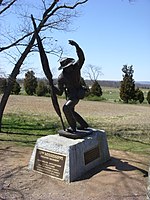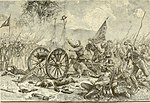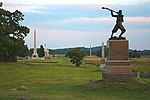North Carolina State Monument (Gettysburg, Pennsylvania)
1929 establishments in Pennsylvania1929 sculpturesBronze sculptures in PennsylvaniaConfederate States of America monuments and memorials in PennsylvaniaFlags in art ... and 6 more
Gettysburg Battlefield monuments and memorialsOutdoor sculptures in PennsylvaniaSculptures by Gutzon BorglumSculptures of men in PennsylvaniaUnited Daughters of the Confederacy monuments and memorialsVague or ambiguous time from May 2011
The North Carolina Monument is a North Carolina memorial of the American Civil War commemorating the 32 Carolina regiments in action at the Battle of Gettysburg. The monument is a public artwork by American sculptor Gutzon Borglum located on Seminary Ridge, West Confederate Avenue, in the Gettysburg National Military Park.
Excerpt from the Wikipedia article North Carolina State Monument (Gettysburg, Pennsylvania) (License: CC BY-SA 3.0, Authors).North Carolina State Monument (Gettysburg, Pennsylvania)
West Confederate Avenue,
Geographical coordinates (GPS) Address Nearby Places Show on map
Geographical coordinates (GPS)
| Latitude | Longitude |
|---|---|
| N 39.81833 ° | E -77.247258 ° |
Address
State of North Carolina
West Confederate Avenue
17325
Pennsylvania, United States
Open on Google Maps










